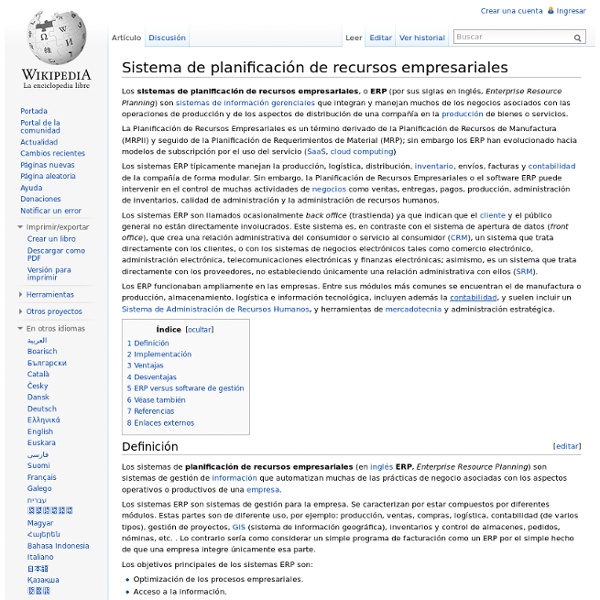What is ERP - Enterprise Resource Planning? A Webopedia.com Definition
By Vangie Beal Enterprise resource planning (ERP) is business process management software that allows an organization to use a system of integrated applications to manage the business and automate many back office functions related to technology, services and human resources. ERP software integrates all facets of an operation — including product planning, development, manufacturing, sales and marketing — in a single database, application and user interface. ERP is an Enterprise Application
Sistema de información
Elementos de un sistema de información. Un sistema de información es un conjunto de elementos orientados al tratamiento y administración de datos e información, organizados y listos para su uso posterior, generados para cubrir una necesidad o un objetivo. Dichos elementos formarán parte de alguna de las siguientes categorías: Todos estos elementos interactúan para procesar los datos (incluidos los procesos manuales y automáticos) y dan lugar a información más elaborada, que se distribuye de la manera más adecuada posible en una determinada organización, en función de sus objetivos.
Dynamics ERP - Enterprise Resource Planning
Enterprise resource planning Microsoft Dynamics enterprise resource planning (ERP) business solution software empowers your people to be more productive and enables your systems to adapt as you grow, while delivering the insight you need to respond quickly in an ever-changing world. Let us help you find the right ERP solution Enterprise organizations A global ERP solution that offers specialized retail, manufacturing, service industry, distribution, and public sector capabilities
Information Systems - The Work Centered Analysis Method
overview of the work-centered analysis method This book is unique because it is organized around a work-centered analysis (WCA) framework which business professionals can use to think about systems. The elements of the framework and the five perspectives are introduced at the outset and then explained in more depth as the text unfolds. A table in the web page explaining how this text is unique summarized the way these ideas are developed throughout the text.
Top 10 ERP and Accounting Software Packages
Looking for accounting software? An ERP system? Below is key information on the top 10 ERP and accounting software packages in the mid-market. In each category, we've selected fact sheets and other information to provide an overview of the software. Download the Guide to Selecting ERP Software
Editions
MySQL is the world's most popular open source database. Whether you are a fast growing web property, technology ISV or large enterprise, MySQL can cost-effectively help you deliver high performance, scalable database applications. MySQL Community Edition is the freely downloadable version of the world's most popular open source database. Commercial customers have the flexibility of choosing from multiple editions to meet specific business and technical requirements: ISVs, OEMs and VARs can learn more about MySQL as an Embedded Database 1 Features only available in Commercial Editions.
Main Phases of Database Design
In the picture below there are the main phases of database design. Database design is connected with application design. The requirements and the collection analysis phase produce both data requirements and functional requirements.
STRUCTURE OF DBMS
DBMS (Database Management System) acts as an interface between the user and the database. The user requests the DBMS to perform various operations (insert, delete, update and retrieval) on the database. The components of DBMS perform these requested operations on the database and provide necessary data to the users.
Top 10 Enterprise Database Systems to Consider
How far back does your knowledge of databases go -- late-1980s, mid-1990s, five years ago? If so, you might not recognize some of the old timers in this list. You'll also do a double take if you didn't know many of them have their roots in the mid-to-late 1970s. It would be hard to argue that the database market is not mature.
Popular Database Management Systems Overview
One of the most influential and widely spread open source database applications that manipulates large databases and can be accessed over the Web is MySQL database server. MySQL runs as a service providing multiple user access to several databases. MySQL is popular for web applications and operates with the database elements for the platforms (Linux/BSD/Mac/Windows). MySQL popularity for use with web applications is closely associated to the popularity of PHP programming language which is often used along with MySQL. Many high-traffic web sites use MySQL as the backend for its data warehouse.
Doc Center : Conceptos básicos de bases de datos
Una base de datos es un conjunto de información organizada de manera que pueda ser utilizada eficientemente. Un directorio telefónico, un diccionario, un calendario o un libro de recetas son ejemplos de bases de datos. La información en una base está organizada en forma de registros. Cada registro contiene toda la información sobre una persona o un elemento de la base. Por ejemplo, cada registro en el directorio telefónico contiene el nombre, dirección y número telefónico de una persona.



